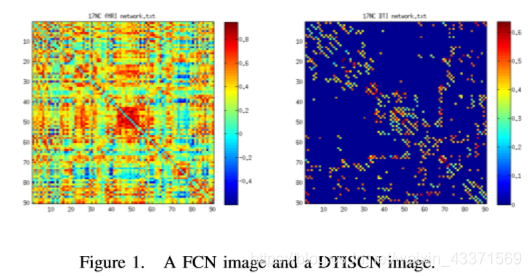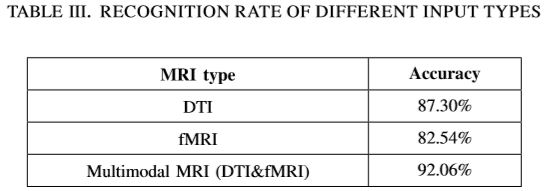一种基于卷积神经网络的老年痴呆症多模态MRI分析方法
摘要: 针对AD的诊断,本文提出了一种基于CNN的多模态MRI分析方法,该方法也适用于单类型MRI数据分析。首先,从多模态MRI数据中提取人脑网络连接矩阵,作为CNN的输入数据。然后提出了一种新的CNN框架来处理网络矩阵,将AD、遗忘性轻度认知障碍(aMCI)患者和正常对照组(NC)进行分类。在我们的实验中,以多模态MRI数据作为输入时,AD、aMCI、NC的综合分类准确率高达92.06%,为多模态MRI数据分析提供了有效的参考。
1、INTRODUCTION
在我们的研究中,提出了一种新的基于CNN的多模态MRI分析方法。该方法将不同类型的MRI数据作为输入进行分类,可以获得分类准确率。利用CNN分析多模态MRI的网络连接矩阵,实现多模态MRI信息融合的CNN卷积核。最后,对本文提出的多模态MRI分析方法进行了讨论。
2、METHODOLOGY
A. Subjects
数据集包括35个AD,30个aMCI,40个正常人。每个受试者由DTI和fMRI数据组成。排除左利手等脑疾病的受试者,确保神经纤维连接的改变不是由AD以外的影响引起的。
B. DTI and fMRI pre-processing
fMRI data processing was performed by using the Resting State Functional Magnetic Resonance Imaging Data Processing Assistant (DPARSF) toolbox. To start with, the first 5 functional images were discarded, because the initial signal of fMRI scanning is instable. Then, the standardization fMRI prep-processing procedures was carried out, including slicetiming correction, Motion correction and so on. Finally, the data was normalized into the Montreal Neurological Institute (MNI) space.
Pre-processing of the DTI date was implemented using a pipeline toolbox, PANDA. During the process, potential head moving affect was removed by rigid body transformation and tri-linear interpolation with the help of PANDA toolbox, and the DTI data was also normalized into the MNI space. At the same time, fractional anisotropy (FA) data was generated.
C. FCN images and DTISCN images extraction
Figure 1 shows images of FCN and DTISCN with the help of GRETNA toolbox.

D. Analysis based on CNN
In deep learning, CNN is mainly applied to image spatial correlation and has shown to be very effective.


III. EXPERIMENTS AND RESULTS
The 105 samples have been used for the experiment, each of which composed of DTI and fMRI data. In order to avoid the inaccuracy caused by data deficiency, data enhancement is implemented before the experiment. Given the fact that the network matrix obtained in the process of connectivity extraction is diagonal symmetry, we could extract the upper and lower triangular matrix without dropping information by the network non-directionality, thus getting 315 samples, which is three times of the original samples.
The results are shown in Table III. With the proposed method above, the classification accuracies were all above 82% when using fMRI, DTI and multimodal MRI (DTI and fMRI) data as input. The highest accuracy, 92.06%, came from multimodal MRI, which was much better than using fMRI or DTI data alone.

IV. DISCUSSION
略
[Reference] A Novel Multimodal MRI Analysis for Alzheimer’s Disease Based on Convolutional Neural Network